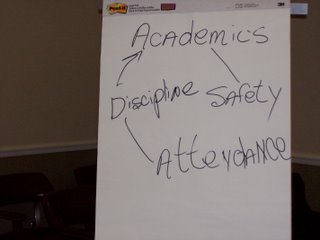School Dropouts-Everyone's Problem

Representatives from Talladega City Schools, Hoover City, Shelby County, Sylacauga City, Chilton County, and Coosa County received a wealth of information about a growing epidemic, STUDENT DROPOUTS, from Jim Toney, a State Department Educational Specialist.
Mr. Toney shared how discipline, safety, and attendance directly affects academics. He asked some important questions such as:
Is there a model of discipline in each classroom?
What is the climate of the school in regards to bullying? Are reports of bullying being ignored or taken seriously? Are policies for attendance being followed? Is school a good place to be? He said our school climates should allow students to learn without fear of failing, feel physically safe, and want to come to school.
Jim referenced a report done by Civic Enterprises entitled "The Silent Epidemic: Perspectives of High School Dropouts." You can download the report by visiting: www.gatesfoundation.org/nr/downloads/ed/TheSilentEpidemic3-06FINAL.pdf The report contains information gathered from surveys of students who chose to dropout. According to the surveys, the top five major factors for leaving school included:
Classes were not interesting 47%
Missed too many days and could not catch up 43%
Spent time with people who were not interested in school 42%
Had too much freedom and not enough rules in my life 38%
Was failing in school 35%
At first I viewed dropouts as a high school problem, but I quickly learned from his presentation that it is a problem that starts much earlier. As an elementary or junior high teacher, it might be helpful to know that student retention of one grade increases the risk of dropping out by 40% to 50% and if there has been more than one grade retention the risk rises to 90%. These retentions usually occur before the student reaches high school. These students need to be flagged so additional support can be offered.
Jim shared that a poor pattern of attendance is the first indicator of a potential dropout. This is a problem seen at the elementary and junior high level every day. He revealed many students who might dropout will begin exhibiting significant signs such as negative behaviors or poor academic performance as early as third, fourth, or fifth grade. Many students aren't ready for the departmentalization in the third or fourth grade and need the added security of a stable personality for the entire day. Being aware of attendance at every grade level is one way we can assist the high school. The report suggests that every day, schools create a reliable list of students who failed to attend school, notify parents or guardians immediately, and take appropriate action. When you look at your students today, those who have had attendance issues throughout their school career could be the next dropouts when they reach the high school level.
According to the 2006-07 Adequate Yearly Progress Status Report, Talladega High School reported a 67% graduation rate. That means for the 2005 seniors only 135 out of the 203 made it to the finish line. 48 students were unsuccessful in completing their education. Twenty members of the class of 2005 only received a certificate of attendance because they did not pass the AHSGE or did not have enough units to pass. Mr. Toney shared that 75% of day crimes are committed by juveniles. Do you see a connection between the dropout problem and the daytime crime rate?
As a former classroom teacher, it was very sad and disturbing to actually read the list of dropout students reported last year from Talladega High School. I recognized many names of children who were students at R.L.Young, my former school and those I knew in the community. It is so easy to just assume they make it to graduation.
So what might help students stay in school? According to the report, most dropouts blame themselves for failing to graduate, but there are things they say schools can do to help them finish.
- Improve teaching and curricula to make school more relevant and engaging and enhance the connection between school and work.
- Improve instruction and access to supports for struggling students.
- Build a school climate that fosters academics.
- Ensure that students have a strong relationship with at least one adult in the school.
- Improve the communication between parents and the schools.
All schools in the district are taking a closer look at their daily attendance. The high school and junior high and elementary schools send letters to parents concerning unexcused absences. Many of our schools make calls daily to parents when their child fails to come to school. Mr. Wilby Wallace, the District Truancy Officer, reaches out to the students on a regular basis. This team effort of administrators, faculty and staff will pay off in helping our children succeed. It will also help with AYP scores which will be released on August 3rd.
As Helen Keller said, "Alone we can do so little; together we can do so much." As a district we can pull together and keep our students in school. Dropouts are everyone's problem.
0 Comments:
Post a Comment
<< Home